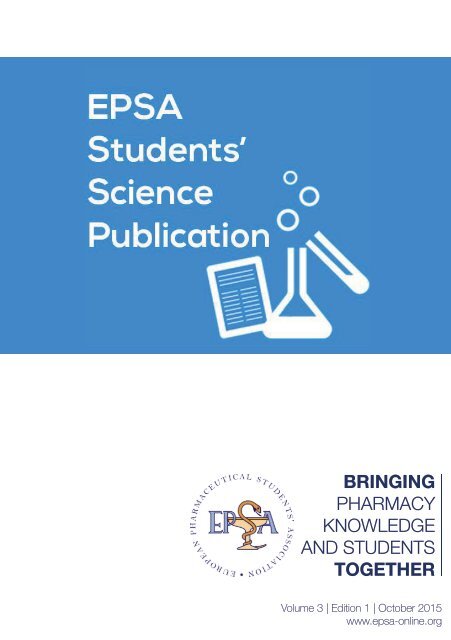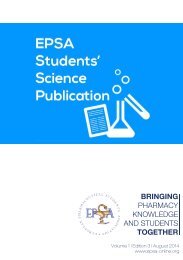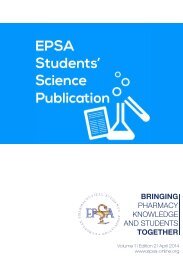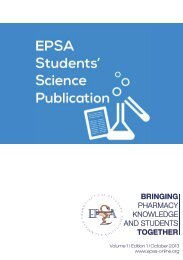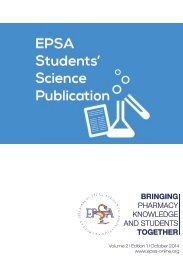essp06
You also want an ePaper? Increase the reach of your titles
YUMPU automatically turns print PDFs into web optimized ePapers that Google loves.
BRINGING<br />
PHARMACY<br />
KNOWLEDGE<br />
AND STUDENTS<br />
TOGETHER<br />
Volume 3 | Edition 1 | October 2015<br />
www.epsa-online.org
EPSA Students' Science Publication<br />
Dear friends,<br />
INTRODUCTION<br />
Another year has passed and it is time for the first edition of the EPSA Students'<br />
Science Publication (ESSP) of this academic year. The ESSP is a project that<br />
allows pharmacy students from around the Europe to publish their scientific<br />
research and outcomes. All of their abstracts are professionally reviewed by the<br />
European Federation for Pharmaceutical Sciences (EUFEPS). The project thus<br />
allows the students insight in the process of writing and publishing abstracts<br />
and, by extension, scientific articles. Every student also has the opportunity to<br />
present themselves and their motivation for conducting the research. Hopefully<br />
reading this edition inspires more students to firstly, try your hand at research<br />
and secondly, write and submit an abstract.<br />
This edition contains four different abstract, covering various topics. You will<br />
learn more about 'Biomedical Potential of Stevia - Stevia rebaudiana (Bert.)<br />
Bertoni', 'Celebrating One Century and Thinking About the Future: Preliminary<br />
Findings for a New MPharm Syllabus at Lisbon Faculty of Pharmacy', 'Synthesis<br />
of a Novel 14-membered Oxo-thia-aza Macrocyclic Compound' and 'The<br />
Influence of Acute Pain on Osmotic Pressure and Cortisol Concentration in<br />
Tears'.<br />
I would like to thank EUFEPS and the EPSA Public Relations Department for<br />
their hard work on this edition and all the students who collaborated on it. This<br />
would not have been possible without all of you.<br />
Looking forward to the future editions!<br />
Eva Shannon Schiffrer, Science Coordinator 2015-2016<br />
2
TABLE OF CONTENT<br />
Volume 3 | Edition 1 | October 2015<br />
Synthesis of a novel 14-membered oxo-thia-aza macrocyclic compound<br />
Abstract ........................................................................................................... 4<br />
Q&A of the author ............................................................................................ 5<br />
Biomedical potential of Stevia - Stevia rebaudiana (Bert.) Bertoni<br />
Abstract ........................................................................................................... 6<br />
Q&A of the author ............................................................................................ 7<br />
Celebrating one century and thinking about the future: preliminary<br />
findings for a new MPharm syllabus at Lisbon Faculty of Pharmacy<br />
Abstract ........................................................................................................... 8<br />
Q&A of the author ............................................................................................ 9<br />
The influence of acute pain on osmotic pressure and cortisol<br />
concentration in tears<br />
Abstract ......................................................................................................... 10<br />
Q&A of the author .......................................................................................... 11<br />
European Federation for Pharmaceutical Sciences (EUFEPS)<br />
Information .................................................................................................... 12<br />
Upcoming conferences ................................................................................. 13<br />
3
EPSA Students' Science Publication<br />
SYNTHESIS OF A NOVEL 14-MEMBERED OXO-THIA-AZA<br />
MACROCYCLIC COMPOUND<br />
João Franco Machado, Judite Costa, Maria F. Cabral<br />
Research Institute for Medicines (iMed.ULisboa), Faculty of Pharmacy, Universidade<br />
de Lisboa, Av. Professor Gama Pinto, 1649-003 Lisbon – Portugal<br />
Background: Macrocyclic compounds have been targets of a widespread<br />
interest in the last decade due to their similarity to the countless analogue<br />
scaffolds found in a variety of biological systems. The unique structural, kinetic<br />
and thermodynamic features of macrocycles, as well as their favourable druglike<br />
properties, have provided a motivation for further study and has had an<br />
enormous impact on the fields of medicine, pharmacy, chemistry and biology.<br />
However, this type of molecule is yet under-exploited as new, effective drugs<br />
and research continues to be fairly limited.<br />
Objective: Following our previous studies, we report the design, synthesis and<br />
structural characterization of a novel oxo-thia-aza macrocyclic compound, the<br />
dioxo-[14]aneN 3<br />
S (1-thia-4,8,12-triazacyclotetradecane-3,13-dione).<br />
Materials and Methods: Dioxo-[14]aneN 3<br />
S was synthesised by reacting<br />
dimethyl thiodiglycolate, previously obtained by Fischer-Speier esterification<br />
technique (η = 89.6 %), with dipropylenetriamine in a large excess of dry<br />
methanol at 40 ºC, under nitrogen atmosphere for 9 days. This procedure<br />
was based on the Tabushi methodology for macrocyclization, which consists<br />
of the condensation of the dimethyl ester of an α,ω-dicarboxylic acid with<br />
a commercially available polyethylenepolyamine. The pure product was<br />
then structurally characterized by infrared and nuclear magnetic resonance<br />
(1H, 13C, COSY, NOESY, HSQC, HMBC) spectroscopies and also by mass<br />
spectrometry.<br />
Results and Conclusion: The improvements in the reaction conditions<br />
introduced to the Tabushi general method (controlled temperature, N 2<br />
atmosphere, increased reaction time, and use of a dry solvent in a large excess)<br />
contributed to achieving - after purification by column chromatography - the<br />
desired macrocycle with a very high yield (η = 76.8 %), compared to the related<br />
compounds synthesised by Tabushi methodology reported in literature (η = 10<br />
~ 20 %). The spectroscopic and spectrometric analyses of dioxo-[14]aneN 3<br />
S<br />
allowed to confirm its chemical structure as well prove its high level of purity.<br />
4
Q&A OF THE AUTHOR<br />
General information about João Franco Machado<br />
22 years old, Sintra, Portugal, Faculty of Pharmacy,<br />
University of Lisbon, joaomachado@campus.ul.pt<br />
Volume 3 | Edition 1 | October 2015<br />
Why did you select this topic for your research?<br />
I am a trainee volunteer at the Research Institute for<br />
Medicines, where I have been developing a research<br />
work in the field of coordination chemistry of macrocyclic<br />
compounds through three years. During this time, I found<br />
out that macrocyclic ligands have a great potential to be<br />
developed as very promising therapeutic agents due to<br />
their unique physicochemical proprieties and also to their range on medical<br />
applications, which had motivated me to design and study novel and effective<br />
macrocycles.<br />
How do you feel about having coped with the challenges that research brings?<br />
When I started the research project that I am now reporting, I already had a<br />
considerable amount of experience which turned out to facilitate my research<br />
work. However, each project is a completely new challenge, because when<br />
we are designing a novel macrocycle, it is possible to figure out that we can’t<br />
properly synthesise it or that it doesn´t show the proprieties we are expecting.<br />
But at the end, and despite all difficulties we can face, the feeling of getting a<br />
novel and promising pharmaceutical compound is very enthusiastic!<br />
What skills did you develop as a researcher during your research period?<br />
During my research period I have not only improved my knowledge in the<br />
different fields of chemistry, but I also developed a set of valuable skills,<br />
such as patience, perseverance, dedication, hardworking, time management,<br />
adaptability, improvising, and critical thinking.<br />
Would you like to share anything else with the students in Europe? Any<br />
recommendations?<br />
The most important advice I can give is to never give up, even if some of<br />
your objectives seem to be quite unlikely to accomplish. Remember that the<br />
dedication leads to the success and at the end, you will experience the most<br />
rewarding feeling you can’t even imagine!<br />
5
EPSA Students' Science Publication<br />
BIOMEDICAL POTENTIAL OF STEVIA - STEVIA<br />
REBAUDIANA (BERT.) BERTONI<br />
Ana Begić and Josip Barilar,<br />
Faculty of Pharmacy and Biochemistry, Zagreb, Croatia<br />
Introduction: Stevia rebaudiana (Bert.) Bertoni (stevia) is a native plant to South<br />
America that is spread worldwide by cultivation due to its use as a natural<br />
sweetener, which is linked to the content of steviol glycoside. In this study,<br />
for the first time in Croatia, pharmacobotanical, phytochemical and biological<br />
studies of stevia were conducted, in order to evaluate its potential biomedical<br />
application possibilities in prevention and treatment.<br />
Aim: The aim of this study was to evaluate micromorphological and anatomical<br />
characteristics of the leaves and young stems, phytochemical composition,<br />
antioxidant effect, reducing power and total antioxidant capacity, ability to<br />
inhibit acetylcholinesterase and inhibitory effect on Src tyrosine kinase.<br />
Materials and Methods: The plant material - Stevia rebaudiana (Bert.) Bertoni<br />
was cultivated in Croatia and collected in August 2012, just before flowering,<br />
and air-dried at room temperature. Identification of plant material was<br />
carried out at the Department of Pharmacognosy, Faculty of Pharmacy and<br />
Biochemistry. The presence of flavonoids, phenolic acids, tannins, saponins,<br />
triterpenoids, sterols and essential oils were detected in methanolic leaf extract<br />
by thin layer chromatography. Contents of total polyphenols, tannins, flavonoids<br />
and phenolic acids in stevia leaves were determined spectrophotometrically.<br />
Antioxidant activities of ethanolic leaf extract were examined by different<br />
spectrophotometric methods in comparison with polyphenolic components and<br />
trolox as a reference. Effect of stevia and its individual bioactive components<br />
on Src tyrosine kinase was investigated by appropriate in vitro assay and<br />
compared with staurosporine.<br />
Results and Conclusion: Our results showed strong antioxidant potential<br />
of stevia, mostly attributed to the phenolic compounds contained.<br />
Acetylcholinesterase (AChE) inhibitory activity of ethanolic leaf extract was<br />
evaluated in comparison with chlorogenic acid and galantamine as a reference.<br />
Stevia showed ability to inhibit AChE exceeding a 50% effect at 1000 μg/mL. It<br />
was also found that chlorogenic acid contributes significantly to its anti-AChE<br />
activity. This research showed that stevia leaves contain a significant amount of<br />
various bioactive components which demonstrated strong antioxidant activity<br />
and ability to inhibit acetylcholinesterase and Src tyrosine kinase. Obtained<br />
results suggested a great potential of stevia in prevention and treatment of<br />
various diseases and that is not just a plant that serves as means of sweetening<br />
food and pharmaceutical products.<br />
6
Q&A OF THE AUTHOR<br />
General information about Ana Begić and Josip<br />
Barilar<br />
Both 25 years, Zagreb, Croatia, ana.<br />
begich@gmail.com, josip.barilar@gmail.com,<br />
University of Zagreb, Faculty of Pharmacy and<br />
Biochemistry<br />
Volume 3 | Edition 1 | October 2015<br />
Why did you select this topic for your research?<br />
The stevia plant caught our attention when we<br />
realized that it has other beneficial biomedical<br />
properties besides being only a natural<br />
sweetener. As the population was using it more in the food industry, we wanted<br />
to prove that stevia also has a potential of prevention and treatment of various<br />
diseases.<br />
How do you feel about having coped with the challenges that research brings?<br />
During a student research, confrontation with different challenges and problems<br />
are fairly common.<br />
One should always try to approach difficulties rationally and try to use different<br />
methods and procedures to minimize the risk of getting bad results. Critical<br />
thinking in the process of research is crucial.<br />
What skills did you develop as a researcher during your research period?<br />
During our research period we've learned to be more tolerant and more<br />
respective of people who dedicate their lives to science. We've also learned<br />
that a round bottom flask should not be placed on a flat surface, because you<br />
will lose the material you've been working on for weeks.<br />
Would you like to share anything else with the students in Europe? Any<br />
recommendations?<br />
We'd like to advise them not to stick their heads in books and blindly believe<br />
what is written. In order to become a successful scientist it is of great importance<br />
to develop creativity because creativity is, along with knowledge, a core to<br />
scientific endeavour.<br />
7
EPSA Students' Science Publication<br />
CELEBRATING ONE CENTURY AND THINKING ABOUT THE<br />
FUTURE: PRELIMINARY FINDINGS FOR A NEW MPHARM<br />
SYLLABUS AT LISBON FACULTY OF PHARMACY<br />
Madalena Plácido, Joana Catarino, Diogo Raimundo and Diana Ferreira<br />
Faculty of Pharmacy of the University of Lisbon, Lisbon, Portugal<br />
Supervisors: Afonso Cavaco, Maria Henriques and Andreia Bruno<br />
Others that contributed to the abstract: Diogo Simões and Francisca Lopes<br />
Introduction: The current curriculum of the Master degree in Pharmacy<br />
(MPharm) of the University of Lisbon is under an accreditation process during<br />
2015. Induced by this evaluation, the Committee for the Centennial Celebrations<br />
of the Students’ Association (CENTAEFFUL) aimed to collect input from<br />
several parties involved in pharmacy education that could contribute to the<br />
improvement of the syllabus towards pharmacy labour opportunities.<br />
Methodology: The research project was divided into three phases. Phase<br />
one consisted of two focus groups, with six pharmaceutical professionals in<br />
each. The second phase was an online survey answered by a national sample<br />
of pharmacy students and pharmacists. The answers were collected through<br />
open and closed questions, including Likert scales to measure the agreement<br />
with sentences stated by professionals from the focus groups. The third<br />
phase was comprised of the presentation and discussion of the survey results<br />
at an Educational Forum (EF). The EF consisted of a two day debate using<br />
an amplification of survey results fed by live presentations of five experts in<br />
educational matters. The actual EF conclusions were accomplished through<br />
small group discussions between pharmacists, students and professors,<br />
complemented by a plenary session opened to the public.<br />
Results: The need to include internships within the first four years of the degree<br />
was mentioned in the focus groups. It was mentioned that having practitioners<br />
outside the university teaching some classes would be beneficial for students.<br />
Concerning the online survey, there were 473 answers. The majority of the<br />
respondents (51.8%) either ‘agreed’ or ‘strongly agreed’ that the current<br />
MPharm curriculum is not completely adapted to practice. Moreover, 77.8%<br />
strongly ‘agreed’ that students would benefit from internships within the first<br />
four years of the degree. EF conclusions supported the opinions previously<br />
mentioned and reinforced the need to introduce new mandatory subjects, such<br />
as non-prescription medicines pharmacotherapy, clinical trials and seminars<br />
about soft-skills. Introducing one more optional subject and increasing the use<br />
of real case studies during classes was also suggested.<br />
Conclusions: Most participants agreed with the need to adapt MPharm to<br />
the competencies required in the pharmaceutical labour market. Throughout<br />
the project several suggestions were able to be collected, which then were<br />
submitted to the Scientific Council, in order to support the changes that needed<br />
to be reflected for the proposal to be submitted for accreditation.<br />
Acknowledges: We would like to acknowledge the Pedagogical Council,<br />
the local and national Students’ Association (AEFFUL and APEF) and all<br />
professionals and students that contributed to this project. We are also grateful<br />
for the support of Merck Sharp & Dohme Portugal.
General information about Madalena<br />
Plácido<br />
During 2014 a Committee for the<br />
Centennial Celebrations of the<br />
Students’ Association (CENTAEFFUL)<br />
was formed. This Committee aimed<br />
to analyse all Students’ Association<br />
journey: its past, present and future<br />
challenges. Focused on a more<br />
educational and scientific aspect, a<br />
Bureau for Education was born.<br />
Q&A OF THE AUTHOR<br />
Volume 3 | Edition 1 | October 2015<br />
Why did you select this topic for your research?<br />
The current curriculum of the Master degree in Pharmacy (MPharm) of<br />
the University of Lisbon is under an accreditation process during 2015. As<br />
members of Bureau for Education we wanted to take this opportunity to analyze<br />
the adequacy of the MPharm syllabus to the labor market through pharmacy<br />
students and professionals’ eyes.<br />
How do you feel about having coped with the challenges that research brings?<br />
The main challenge was to define the right modus operandi for our research.<br />
Luckily we benefited from the help of professionals and faculty professors, to<br />
whom we are deeply grateful. Another challenge was the gap between academy<br />
and practice, which we tried to shorten through this investigation work.<br />
What skills did you develop as a researcher during your research period?<br />
This kind of research allowed us to develop our critical thinking and data<br />
analysis abilities. We also improved our communication and organizational<br />
skills. Moreover, our awareness about the current MPharm syllabus and the<br />
labor market needs also increased.<br />
Would you like to share anything else with the students in Europe? Any<br />
recommendations?<br />
Research is not only discovering new drugs or a cure for a disease. If you<br />
believe that you can make a difference in your own university, go ahead!<br />
Understand the opinion of professionals from different areas, professors and<br />
your colleagues. Certainly you will learn something new and contribute to<br />
improve your university.<br />
9
EPSA Students' Science Publication<br />
THE INFLUENCE OF ACUTE PAIN ON OSMOTIC PRESSURE<br />
AND CORTISOL CONCENTRATION IN TEARS<br />
Maja Lukić and Matea Ćurčić,<br />
Faculty of Pharmacy and Medical Biochemistry, University of Zagreb, Croatia<br />
Introduction: Tears are far more than just a fluid on the surface of our eyes.<br />
Consisting of three distinct layers, they are essential for eye protection,<br />
lubrication and nourishment as well as maintaining health of the eyes and<br />
optical function of their surface and for providing clear vision. Furthermore, tears<br />
prevent eye infections by continually removing foreign matter thus, keeping the<br />
surface of the eyes smooth and clear. Tear production is controlled both by the<br />
central and autonomic nervous system. While basal tears’ production is under<br />
control of the accessory lacrimal glands, reflex lacrimation is mediated by the<br />
neural reflex arc that stimulates the secretion of the main lacrimal glands. Pain<br />
causes stress to the organism and therefore, production of stress mediators<br />
is stimulated. Cortisol is, along with DHEA, adrenalin and noradrenalin, one of<br />
the four main stress mediators. Although the origin of cortisol in tears is not<br />
known yet, it is assumed it might derive from the lacrimal gland. The final result<br />
of the dynamic changes of the lacrimal fluid is determined by measuring the<br />
osmolarity of the lacrimal fluid.<br />
Aim: In this study, the applicability of tears in the diagnostics of acute stress<br />
was evaluated. The main objectives of the study were to evaluate cortisol values<br />
and osmotic concentration in tears before and after stimulus and whether a<br />
consistent answer to stress could be diagnosed in tears.<br />
Materials and Methods: The study included 18 volunteers (10 women and 8<br />
men) whose tears were collected and analysed at the Clinical Hospital Center<br />
'Sestre Milosrdnice'. The tear samples were collected before and after nasal<br />
hair trimming. The concentration of cortisol was measured using ELISA whilst<br />
osmometry was used as a method to determine the osmolar concentration.<br />
Results and Conclusion: Basal cortisol values in men showed good correlation<br />
with osmolarity in tears. After acute stress, this correlation was lost, which<br />
can be due to the higher sensitivity to pain in males. After stimulus, cortisol<br />
and osmolar concentration decreased due to the dilution caused by tear<br />
production. Osmolarity and cortisol showed a moderate correlation before the<br />
painful stimulus, which is completely lost after the stimulus. Pain stimulus at<br />
the root hairs activates the sympathetic nervous system and its possible effect<br />
on the secretion of glands.<br />
10
Q&A OF THE AUTHOR<br />
General information about Maja Lukić<br />
27 years old, Osijek, Republic of Croatia<br />
E-mail: maja__lukic@hotmail.com<br />
The faculty of Pharmacy and Medical Biochemistry<br />
(Graduated 2015), University of Zagreb<br />
Why did you select this topic for your research?<br />
The idea of the topic came spontaneously but from the<br />
very beginning Matea and I knew we wanted to conduct<br />
an investigation on tears, as they as a sample are rarely<br />
used in clinical practice.<br />
Volume 3 | Edition 1 | October 2015<br />
How do you feel about having coped with the challenges that research brings?<br />
From the very beginning, there were a lot of challenging aspects of our<br />
investigation. Firstly, tears collection and limited sample volume, as well as<br />
analyte measurement in a low concentration range. Moreover, there was no<br />
available literature on studies of human tears. Despite all, we did not give up<br />
and succedeed in obtaining our results.<br />
What skills did you develop as a researcher during your research period?<br />
Above all, patience, organizational skills, accuracy and punctuality.<br />
Would you like to share anything else with the students in Europe? Any<br />
recommendations?<br />
I strongly recommend conducting an investigation during their studies. In<br />
this way, you can gain great experience in the field of your study and through<br />
cooperation with your colleagues, gain new friends.<br />
11
EPSA Students' Science Publication<br />
EUROPEAN FEDERATION FOR PHARMACEUTICAL<br />
SCIENCES (EUFEPS)<br />
The European Federation for Pharmaceutical Sciences is a voluntary federation<br />
of national associations and societies of pharmaceutical scientists, established<br />
in 1991 to advance research in the pharmaceutical sciences in Europe.<br />
This can be achieved by promoting cooperation between national, regional<br />
and European societies or associations which aim at the advancement of<br />
pharmaceutical sciences, and by promoting cooperation between and with<br />
other pharmaceutical organisations and between individual pharmaceutical<br />
scientists.<br />
The Mission<br />
EUFEPS exists to help to meet the challenges and seize the opportunities<br />
created by the consolidations occurring both within Europe and globally,<br />
driven on by a combination of rapid advances in science and technology,<br />
economic pressures, and by political will. Within this frame, EUFEPS’s mission<br />
is to advance sciences for better medicines and health and serving the<br />
pharmaceutical sciences and innovative drug research in Europe. Spearheading<br />
a number of initiatives, EUFEPS works with its membership, throughout many<br />
nations in Europe.<br />
European Dimension<br />
EUFEPS is unique being the only pan-European organisation that represents,<br />
under one umbrella, all the pharmaceutical sciences and pharmaceutical<br />
scientists engaged in drug research and development, drug regulation and drug<br />
policy making. The existence of such an umbrella platform facilitates the highly<br />
innovative, integrative and interdisciplinary approaches that are essential if we,<br />
in Europe, are to deliver to our citizens safe, effective, economic and timely<br />
medicines. The ultimate benefits are an improving health, quality of life, and<br />
wealth of our continent.<br />
EUFEPS is recognised by the European Commission, as representing the<br />
integrative pharmaceutical sciences within Europe. EUEFPS is also recognised<br />
by the EMEA as a neutral scientific resource for independent opinions on draft<br />
regulatory guidelines, while EUFEPS works with other European organisations,<br />
such as EFPIA, to help identify and promote training to meet industrial<br />
needs. EUFEPS has the ambition to provide a forum for policy development<br />
in the pharmaceutical sciences, particularly in relations to the discovery and<br />
development of new drugs and their introduction into the market, but also as<br />
to medicines usage. This includes policies on and leadership development as<br />
to: research, education & training, profiling and regulatory affairs.<br />
12
Volume 3 | Edition 1 | October 2015<br />
In addition, EUFEPS plays an active and influential role also in the global arena.<br />
It is recognised by the USA FDA and it works actively with its sister organisation<br />
AAPS to develop co-sponsored meetings and workshops that run alternatively<br />
in Europe and the USA, and is developing links with Asian scientists. Through<br />
involvement with its Board of Pharmaceutical Sciences, EUFEPS is also<br />
working with FIP to advance the pharmaceutical sciences globally.<br />
UPCOMING CONFERENCES ORGANISED OR CO-<br />
ORGANISED BY EUFEPS<br />
8 th International Symposium on Microdialysis<br />
Preclinical, Clinical, Analytical<br />
25-27 May 2016, Uppsala, Sweden<br />
EUFEPS Annual Meeting 2016<br />
Clinical Outcome and Regulation of Advanced Drug Delivery Products<br />
13-15 June 2016, Istanbul, Turkey<br />
8 th Pan-European Science Conference on QbD and PAT Sciences<br />
Inventing Tomorrow’s Development and Manufacturing<br />
3-4 October 2016, Cork, Ireland<br />
2 nd Conference on the Global Bioequivalence Harmonisation Initiative<br />
Autumn 2016, Washington DC, United States of America<br />
For more information see conferences at: www.eufeps.org<br />
13
EPSA Students' Science Publication
Volume 3 | Edition 1 | October 2015<br />
WHAT DOES EPSA OFFER IN THE FIELD OF SCIENCE?<br />
Next to the EPSA Students' Science Publication (ESSP) that you are reading<br />
now, EPSA also offers two other projects in the field of Science: the Science<br />
Day and the Science Excursion.<br />
Science Day<br />
The Science Day is an annual<br />
educational event that takes place<br />
during the EPSA Annual Congress<br />
and is dedicated to students’<br />
scientific work. Participants are<br />
given the opportunity to present<br />
the scientific research they have<br />
conducted orally and through a<br />
poster exhibition. This year fourteen students in total participated in one or two<br />
parts of the event. A jury, consisting of the European Federation for Pharmaceutical<br />
Sciences, EUFEPS representative, a Pierre Fabre Lab. Representative<br />
and the EPSA Science Coordinator Successor, assessed the presentations.<br />
Since the competition this year was extremely tough, the jury agreed on two<br />
winners for the oral presentation.<br />
Science Excursion<br />
The idea of the Science<br />
Excursion is to bring students<br />
closer to science and to broaden<br />
the Congress experience to an<br />
interactive and local surrounding.<br />
It is a project that is planned to<br />
be held at all major EPSA events.<br />
The upcoming excursion will<br />
be held during the Autumn<br />
Assembly in the restored oldest pharmacy in the Santo Spirito Hospital in<br />
Malta. Participants will visit the pharmacy museum and witness a compounding<br />
demonstration.<br />
15


